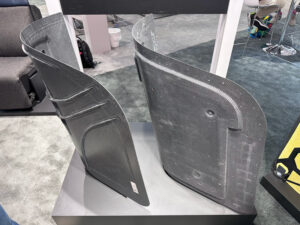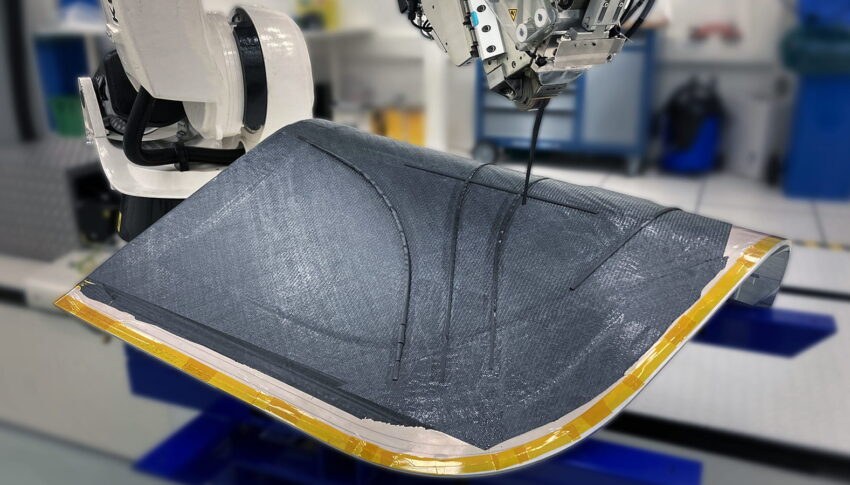Structural weight reduction within the cabin, and particularly within expensive and heavy business class seats that can make up as much as half of an airline’s profit margin for a longhaul flight, is a crucial element of aviation’s efforts to reduce its climate impact. Collins Aerospace’s STARLight, a new robotic manufacturing process for advanced materials in structural technology, is a substantial breakthrough, and we got up and close at the Aircraft Interiors Expo in Hamburg.
At its core, Collins says, “STARLight structures are ultra-lightweight, strong and sustainable composite structures that can easily integrate into many cabin interior spaces — including seats, galleys, monuments, lavatories, interior linings and more.”
In essence, the STARLight process uses additive manufacturing to add structural ribs to composite elements, allowing them to be substantially thinner in their primary structure than they would be using existing processes.
“Advanced composite design tools, automated manufacturing techniques and the use of renewable materials result in architectures that are thinner and lighter weight than traditional honeycomb panels. The monolithic structures are reinforced with stiffeners that match the shape and curvature of the final structure, providing enhanced strength, reliability and integrity to the end product,” explains the manufacturer.
In current manufacturing processes, the general technique is to join composite honeycomb panels together with fasteners and/or adhesives, which add both weight and complexity: fasteners can fail and the holes needed for them can cause structural weakness, while adhesives often complicate production, certification (especially around heat, smoke and toxicity requirements) and reliability.
 On show at the expo — the primary annual event for cabin interiors, this year dominated by discussions of sustainability and emissions reduction — was the backshell element of the Collins AirLounge seat used for Finnair’s new business class. This was around a centimetre thinner in key areas, and if extrapolated over 30 to 60 rows of an aircraft that’s a major gain in space as well as the further benefits that stem from using additive manufacturing rather than other, older processes.
On show at the expo — the primary annual event for cabin interiors, this year dominated by discussions of sustainability and emissions reduction — was the backshell element of the Collins AirLounge seat used for Finnair’s new business class. This was around a centimetre thinner in key areas, and if extrapolated over 30 to 60 rows of an aircraft that’s a major gain in space as well as the further benefits that stem from using additive manufacturing rather than other, older processes.
“The advanced machining techniques utilised by STARLight technologies eliminate the need for pre-preg fabric, adhesives and bonding in the material assembly process,” Collins notes, “not only eliminating structural weight but also leading to a significant reduction in material waste and energy-intensive processes in manufacturing.”
STARLight — which, in something of an acronym stretch, stands for Sustainable Tailored Architecture using Robotic manufacturing for LIGHT weight composite structures — achieves impressive reductions in weight, part count, potting chemicals (for the finish), manual labour, materials usage and CO2 emissions. Meanwhile, quality, repeatability and scalability are all improved.
The STARLight structures achieve a 45% reduction in overall materials usage versus the traditional shell as a result of being, in essence, an additive manufacturing process where the structural ribs are added onto the base shell rather than being sculpted away. They also cut part count from hundreds down to two.
The robotics, meanwhile, cut manual labour required in half, while the use of novel bio-materials cut direct CO2 emissions in half — with an overall 25% structural weight reduction compared with the legacy monument bringing further lifecycle CO2 reductions at greater orders of magnitude.
In a sign of just how impressive STARLight’s technological advances are — and indeed how keen the cabin interiors sector of aviation manufacturing is to reduce carbon emissions, particularly in terms of structural weight — it won the Materials and Components category award at this year’s Crystal Cabin Awards. Frequently referred to as the Oscars of cabin interiors, the awards are judged by senior leaders from within aviation and wider industry, as well as technical experts from academia.



